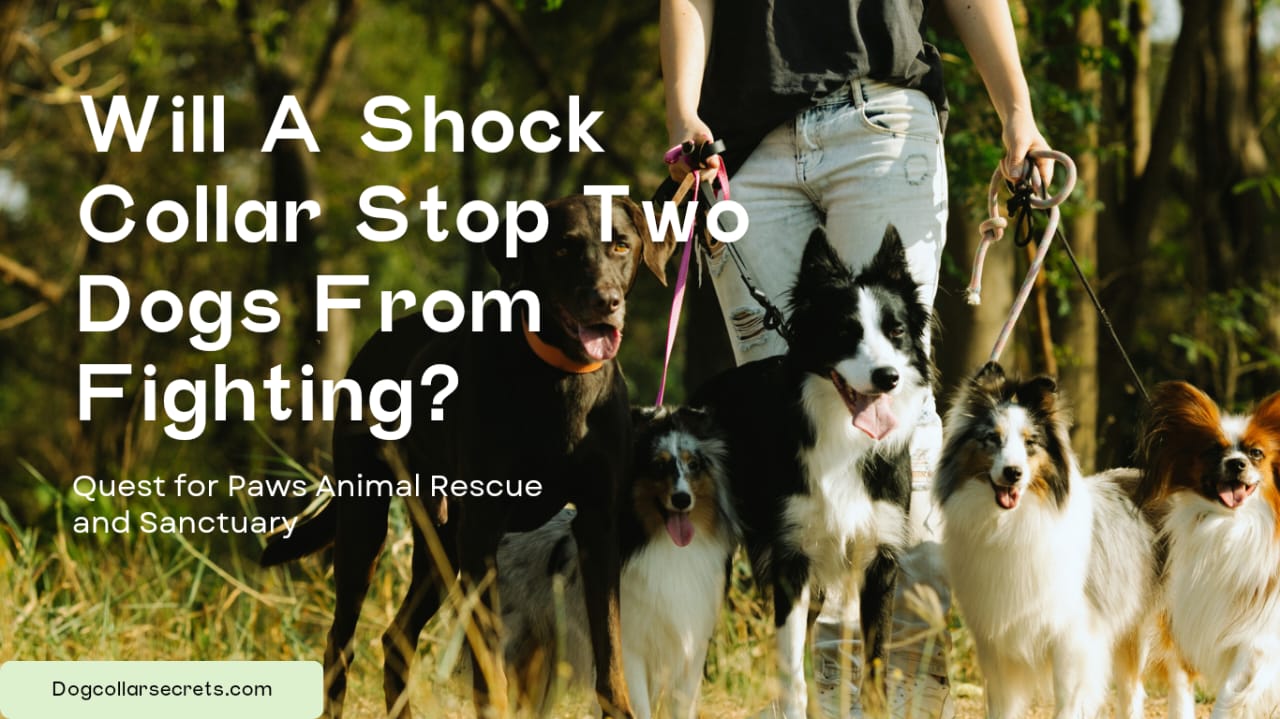Shock Collars: Will a shock collar stop two dogs from fighting?

Will a shock collar stop two dogs from fighting?
In this article, we will explore the question: Will a shock collar stop two dogs from fighting? When our beloved pets engage in a brawl, it’s only natural for us to want to protect them. People often consider using shock collars to break up pet fights, but it’s vital to recognize that shock collars may not be effective. In fact, shock collars can sometimes escalate the aggression, intensifying the dogs’ fighting behavior.
However, the decision to use a shock collar in such situations raises important concerns. To truly understand the implications and effectiveness of shock collars in managing dog fights, we’ll delve into the mechanics of these devices, the potential risks they pose, and alternative, safer methods to ensure the safety and well-being of our canine companions.
Will a shock collar stop two dogs from fighting? Exploring Shock Collars
The Mechanics of Shock Collars:
Understanding how shock collars work is essential to assess their effectiveness. These devices are designed to deliver an electric stimulus, often in the form of a static shock or vibration, to the dog when a specific behavior is detected. Proponents argue that this stimulus can deter dogs from undesirable actions. However, it’s crucial to note that the effectiveness can vary widely depending on factors like the dog’s temperament, the intensity of the shock, and the timing of the correction.
Potential Risks and Consequences:
The use of shock collars in dog fights can lead to significant risks and consequences. As mentioned earlier, these devices may not reliably halt a fight, and in some cases, they can exacerbate the aggression between the dogs. This escalation can result in physical harm to both the dogs and the individuals attempting to intervene. Moreover, shock collars can lead to emotional distress, fear, and anxiety in dogs, potentially causing long-term behavioral issues.
In the next sections of this article, we will delve deeper into the debate surrounding the effectiveness and safety of shock collars in managing dog fights. We’ll explore alternative methods and best practices for ensuring the well-being of our pets when they find themselves in challenging situations.
Can a Shock Collar Really Stop Two Dogs from Fighting?
In the world of pet ownership, clashes between our furry friends can sometimes turn into chaotic and frightening events. When two dogs engage in a heated altercation, many pet owners may instinctively consider using a shock collar or even a cattle prod to intervene and break up the fight. But is this really a reliable solution? Let’s dive into the question: Will a shock collar stop two dogs from fighting?
Understanding the Instinct to Intervene
When our beloved pets engage in a brawl, it’s only natural for us to want to protect them and prevent injuries. The idea of using a shock collar or cattle prod may seem like a quick fix, but it’s essential to grasp the potential consequences of such actions.
The Truth About Shock Collars
A Temporary Distraction
Shock collars are designed to deliver an electric stimulus, essentially giving the dog a shock. In some cases, this can be an effective tool for training and behavior modification. However, using a shock collar to break up a dog fight often proves counterproductive.
Heightened Aggression
Contrary to what one might expect, the sudden jolt from a shock collar can actually escalate the aggression between the two dogs. Rather than deterring the fight, it can further agitate them, intensifying their combativeness.
Risk of Fear and Trauma
Dogs subjected to electric shocks during fights can develop fear and anxiety towards other dogs, potentially causing long-term behavioral issues.
A Safer and More Effective Approach
So, if shock collars aren’t the answer, what should you do when your dogs are at odds?
1. Stay Calm: Your emotional state plays a significant role in diffusing the situation. Stay as composed as possible to avoid exacerbating the dogs’ agitation.
2. Avoid Physical Intervention: Attempting to physically separate fighting dogs can lead to severe injuries for both you and the dogs. It’s best to avoid this at all costs.
3. Use Distraction Techniques: Instead of resorting to shock collars, use loud noises, like clapping your hands or using a whistle, to startle the dogs. This may divert their attention away from the fight.
4. Seek Professional Help: In cases of persistent aggression, consult a professional dog trainer or behaviorist who specializes in handling aggression issues. They can provide tailored strategies for managing and reducing aggression between your dogs.
5. Prevent Future Conflicts: Once the fight is resolved, take steps to prevent future conflicts. Keep your dogs separated when you’re not around, gradually reintroduce them under supervision, and monitor their interactions closely.
Do shock collars stop aggressive dogs?
The use of shock collars to stop aggression in dogs is a matter of debate among experts and animal advocates. While shock collars can sometimes be effective in curbing certain behaviors, including aggression, their use must be approached with caution and ethical considerations.
Shock collars work by delivering an electric stimulus to a dog when they exhibit specific behaviors. In some cases, this can interrupt an aggressive action momentarily. However, it’s essential to understand that aggression in dogs often has underlying causes, such as fear, anxiety, or territorial issues. Shock collars may suppress the aggressive behavior temporarily, but they do not address the root cause of the aggression.
Moreover, using shock collars to stop aggression can have adverse consequences. It can lead to increased fear and anxiety in the dog, potentially exacerbating the aggression or causing other behavioral problems. Many experts advocate for positive reinforcement training and behavior modification techniques to address aggression in dogs. These methods focus on rewarding desired behaviors, creating a more positive and trusting relationship between the dog and owner, and addressing the root causes of aggression in a humane and effective way.
Do shock collars work on fighting dogs?
Using shock collars on fighting dogs is a topic that raises important questions about their effectiveness and safety. Shock collars, also known as electronic or e-collars, are designed to deliver an electric stimulus to a dog when a certain behavior is exhibited. While they can be used for training purposes, using shock collars on fighting dogs is generally not recommended, and here’s why.
- Firstly, shock collars may not work effectively in breaking up a dog fight. In the heat of a fight, dogs are often in an elevated state of arousal and aggression. The shock from the collar might not deter them from fighting and could even make them more agitated. Instead of separating the dogs, it may escalate the situation further.
- Secondly, using shock collars on fighting dogs can have detrimental consequences. The electric shocks can cause physical pain and emotional distress, potentially leading to fear and anxiety in the dogs. This can result in long-term behavioral problems and a negative impact on the dogs’ overall well-being.
While shock collars have their place in dog training, they are not a suitable solution for breaking up fights between dogs. Safer alternatives, such as the Wheelbarrow Method or seeking professional help to address the underlying causes of aggression, are recommended to ensure the safety and well-being of both the dogs and those trying to intervene.
Conclusion
In conclusion, the central question remains: Will a shock collar stop two dogs from fighting? The answer isn’t straightforward. Shock collars are controversial and can be risky. They might not reliably stop fights and could even make things worse. Plus, they can hurt dogs physically and emotionally.
Instead of shock collars, it’s better to focus on safer methods. Techniques like the Wheelbarrow Method, which emphasizes everyone’s safety, or getting help from a professional who understands dog behavior can be more responsible ways to handle dog fights. Ultimately, the well-being of our dogs should be the most important thing, and we should choose methods that ensure their safety and happiness along with ours.
You can also read this: Is A Shock Collar Bad For Dogs?
What Can I Use Instead Of A Shock Collar?
Can You Use A Shock Collar On A Puppy?
FAQ
What are the side effects of shock collars?
Shock collars can have adverse side effects on dogs, including fear, anxiety, aggression escalation, physical harm, negative associations, and behavioral issues. It’s important to consider these risks and explore alternative training methods.
Do vets recommend shock collars?
Many veterinarians do not recommend shock collars due to concerns about their potential harm and adverse effects on dogs. It’s essential to consult with a vet and explore alternative training methods that prioritize positive reinforcement and your pet’s well-being.
Should dogs sleep with shock collars?
No, dogs should not sleep with shock collars on. It’s essential to remove shock collars during sleep to ensure the comfort and safety of the dog.
When should you not use a shock collar?
Training a dog with a shock collar involves these steps: Learn usage, use positive reinforcement, start with low settings, be consistent, time the shocks, teach commands, monitor reactions, and consider professional guidance. Always prioritize positive reinforcement over shocks in training.
How effective are shock collars?
The effectiveness of shock collars varies from dog to dog. While they may temporarily stop certain behaviors, their long-term effectiveness is debatable. Many experts advocate for alternative training methods like positive reinforcement, often considered safer and more humane.




